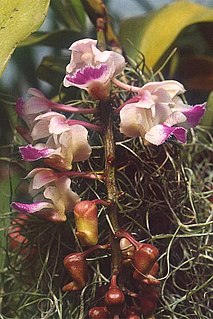
The Andaman and Nicobar Islands, one of the nine union territories of India comprising 572 islands of which 37 are inhabited, are a group of islands at the juncture of the Bay of Bengal and Andaman Sea.

Aerides, known commonly as cat's-tail orchids and fox brush orchids, is a genus belonging to the orchid family. It is a group of tropical epiphyte orchids that grow mainly in the warm lowlands of tropical Asia from India to southern China to New Guinea. They are valued in horticulture for their racemes of showy, fragrant, colorful flowers.

Homonoia is a plant genus of the family Euphorbiaceae first described in 1790. These are rheophytes and usually found in groups at riverbanks in India, southern China, Southeast Asia, and New Guinea.
- Homonoia intermediaHaines - India
- Homonoia retusa Müll.Arg. - India
- Homonoia riparia Lour. - Guangxi, Guizhou, Hainan, Sichuan, Taiwan, Yunnan, Cambodia, India, Assam, Bhutan, Sri Lanka, Borneo, Java, Lesser Sunda Islands, Sulawesi, Sumatra, Maluku, Laos, Malaysia, Myanmar, Philippines, Thailand, Vietnam, New Guinea, Andaman & Nicobar Islands

The flora of India is one of the richest in the world due to the wide range of climate, topology and habitat in the country. There are estimated to be over 18,000 species of flowering plants in India, which constitute some 6-7 percent of the total plant species in the world. India is home to more than 50,000 species of plants, including a variety of endemics. The use of plants as a source of medicines has been an integral part of life in India from the earliest times. There are more than 3000 Indian plant species officially documented as possessing into eight main floristic regions : Western Himalayas, Eastern Himalayas, Assam, Indus plain, Ganges plain, the Deccan, Malabar and the Andaman Islands.

Chionanthus, common name: fringetrees, is a genus of about 150 species of flowering plants in the family Oleaceae.

Acampe rigida is a species of orchid. It is native to China, India, Assam, Bangladesh, Nepal, Sri Lanka, Andaman Islands, Cambodia, Laos, Myanmar, Thailand, Vietnam, Malaya, and the Philippines.

Dendrobium chrysotoxum is a widely cultivated species of orchid. It is native to Southeast Asia, and has been found in the wild in Burma (Myanmar), Bhutan, Yunnan (China), Assam (India), Bangladesh, Andaman Islands, Laos, Nepal, Thailand, and Vietnam.

Dendrobium secundum, also known as the toothbrush orchid, is a species of flowering plant in the genus Dendrobium of the family Orchidaceae. The common name refers to the fact that all the flowers are on the same side of the stem, much like the bristles all on one side of a toothbrush.

Dendrobium tortile is a species of orchid, commonly known as the twisted dendrobium. It is native across Southeast Asia, and in Bangladesh, Assam state of India, and the Andaman Islands.

Gastrochilus obliquus is a species of orchid native to China, the Himalayas and Southeast Asia. Two varieties are recognized:
Pteroceras muriculatum is an endemic endangered orchid reported from the Andaman Islands in the Bay of Bengal. This insular orchid was first described by Reichenbach in 1881 as Thrixspermum muriculatum Rchb. f. based on a few specimens procured during the latter part of 19th century by Mr W. Bull. This taxon has not been reported until 2005 after the type collection. During the floristic survey of South Andaman Islands carried out by Sam Mathew for the 'Flora India Project' of the Botanical Survey of India, this taxon was relocated in 1993 from the semievergreen forests at Chidiyatappu region. Pteroceras muriculatum P. F. Hunt is a beautiful small epiphytic orchid having creamy white flowers with distinct transverse purple bands on petals. A living specimen collected from South Andaman Island is conserving at the Field Gene Bank of Jawaharlal Nehru Tropical Botanic Garden and Research Institute, Trivandrum, India.

Thuarea is a genus of plants in the grass family, native to Asia, Africa, Australia, and various islands of the Indian and Pacific Oceans.

Eragrostiella is a genus of Asian, African, and Australian plants in the grass family.
Pteroceras is a genus of flowering plants from the orchid family, Orchidaceae. It is native to China, the Indian Subcontinent, and Southeast Asia.

Meganoton nyctiphanes, the dull double-bristled hawkmoth, is a moth of the family Sphingidae. It is known from Sri Lanka, India, Bangladesh, Myanmar, the Nicobar Islands, the Andaman Islands, south-eastern China, Thailand, Vietnam, Malaysia, Sumatra, Indonesia and the Philippines (Palawan).

Ancistrocladus tectorius is a species in the monogeneric family Ancistrocladaceae found in China (Hainan), Cambodia, India, Indonesia, Laos, Malaysia, Myanmar, Singapore, Thailand, and Vietnam. The Vietnamese name is trung quân lợp nhà; Chinese: 钩枝藤, gou zhi teng.

Anisomeles, with common name catteeth, is a genus of herbaceous plants of the family Lamiaceae first described in 1909. It is native to China, the Indian Subcontinent, Southeast Asia, New Guinea, Australia, Madagascar, and assorted islands of the Pacific and Indian Oceans.
- Anisomeles candicansBenth. - Myanmar, Thailand
- Anisomeles heyneanaBenth. - India, Bangladesh
- Anisomeles indica(L.) Kuntze - China, Tibet, Himalayas, India, Bangladesh, Nepal, Sri Lanka, Maldive Islands, Lakshadweep, Andaman & Nicobar Islands, Indochina, Malaysia, Indonesia, Philippines, New Guinea, Christmas Island, Bismarck Archipelago, Mauritius, Madagascar; naturalized in Fiji, Samoa, Jamaica, Trinidad
- Anisomeles malabarica(L.) R.Br. ex Sims - India, Bangladesh, Sri Lanka, Andaman & Nicobar Islands, Thailand, Malaysia, Indonesia, New Guinea, Bismarck Archipelago, Mauritius, Réunion, northern Australia
- Anisomeles salviifoliaR.Br. - New Guinea, Northern Territory of Australia

Bridelia retusa is a species of Bridelia found in Bangladesh, Nepal, India, Sri Lanka, southern China, Indochina, Thailand and Sumatra.
Cyperus laxus is a sedge species in the Cyperaceae. It is native to tropical regions of the Western Hemisphere and also to Africa. The species is reportedly naturalized in Assam and the Andaman and Nicobar Islands.

Myxopyrum is a plant genus native to India, southern China, Southeast Asia and New Guinea. There are at present 4 recognized species:



















